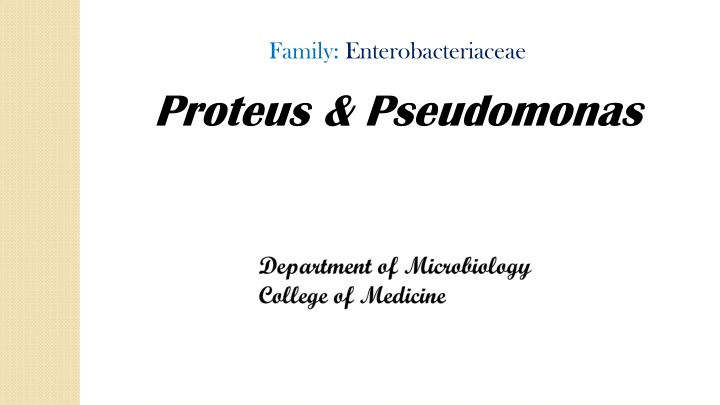
Overview of Proteus Bacteria: Characteristics, Diagnosis, and Serology
Learn about Proteus bacteria, a Gram-negative rod causing UTIs and wound infections. Explore laboratory diagnosis methods, including culture and biochemical tests. Discover the significance of serology in detecting Proteus infections. Additionally, get insights into the Weil-Felix test for rickettsial diseases.
Download Presentation

Please find below an Image/Link to download the presentation.
The content on the website is provided AS IS for your information and personal use only. It may not be sold, licensed, or shared on other websites without obtaining consent from the author. If you encounter any issues during the download, it is possible that the publisher has removed the file from their server.
You are allowed to download the files provided on this website for personal or commercial use, subject to the condition that they are used lawfully. All files are the property of their respective owners.
The content on the website is provided AS IS for your information and personal use only. It may not be sold, licensed, or shared on other websites without obtaining consent from the author.
E N D
Presentation Transcript
Family: Enterobacteriaceae Proteus & Pseudomonas
Proteus Gram-ve , actively motile pleomorphism rods. Causes UTI, cystitis, wound infections. Four speices ; Proteus morgani, Proteus vulgaris, Proteus mirabilis and Proteus rettgeri are distinguished from each other on the bases of fermentation of maltose, mannitol, sucrose and the production of indole. All Proteus species are indole +ve except Proteus mirabilis. All Proteus do not ferment mannitol except Proteus rettgeri (late fermenter).
Labrotory diagnosis: Specimen; urine, exudates, swabs. Smear; G-ve bacilli.
Culture; 1. MacConkey Proteus appear as a non- lactose fermenter. (colorless colonies). 2. EMB . There is no metallic sheen on EMB. 3. S.S agar .Proteus appear as pale colonies with black centers. 4. Blood agar highly motile ( swarming), therefore they produce swarming spread overgrowth on blood agar plate .swarming is characterized by expanding rings (waves) over the surface of blood agar. Blood agar (swarming)
Biochemical tests; TSI ; K / A Gas +ve H2S +ve Or ; A / A Gas +ve H2S +ve IMViC -- ++ -
3- Urease test: + ve Converting the slant of urea agar from yellow color to pink- purple color due to the utilization of urea by urease enzyme(produced by proteus) and the formation of ammonia converting the medium into an alkaline pH and producing a pink purple color by a change in the phenol red indicator.
Serology: certain serotypes of proteus have cross-reacting Ags with some Rickettsias, It serves as a useful clinical tool to determine if a person has been infected with rickettsia . Mixing the serum of a patient suspected of having a rickettsial disease with Ag form Ab Ag will agglutinate ,indicating +ve results; ( weil- felix test).
The Weil-Felix is based on cross reaction which occur between antibodies produced in acute reckettsial infection with antigens of OX (OX2, OX19, and OXK) strains of proteus sp. Used to diagnosed typhus and other reckettsial diseases.
Pseudomonas A genus of Gram-negative, non sporeforming, rod-shaped bacteria. Motile species possess polar flagella. They are strictly aerobic. Members of the genus Pseudomonas cause a variety of infective diseases Pseudomonas aeruginosa is the most significant cause of hospital-acquired infections. The spectrum of clinical disease ranges from urinary tract infections to septicemia, pneumonia, meningitis, and infections of postsurgical and posttraumatic wounds.
Pseudomonas pigments; 1.pyocyanin . Blue color 2. pyoverdin .green (fluorescent) color 3. Pyorubin .. reddish brown color 4.Pyomelanin . Black color Some strains of pseudomonas however do not produce any of these pigments.
Pseudomonas aerogenosa: a common isolate from wounds, burns and urinary tract infections and from many other accumulations of pus . Also commonly found in otitis. Its presence may be indicated by a distinctive blue or green color of the pus or infected site.
Laboratory diagnosis; Specimen: urine , pus, blood, CSF, sputum, swab. Culture: 1.MacConkey Pseudomonas appears as a non lactose fermenter. 2.EMB......there is no metallic sheen on EMB agar. 3.Nutrient agar.... Pseudomonas aerogenosa produces a blue green pigment and a fruity aroma. Milk agar may be added to nutrient agar to give a white background.
Pseudomonas Pyocyanine Pigment
Biochemical tests: 1-I M Vi C - - - + 2- TSI: no change k/k Gas ve H 2S ve 3- oxidase + ve
Is a Gram negative comma-shaped bacterium with a polar flagellum that causes cholera in humans. The types of V. cholerae according to their antigenic structure; a-classical type b- El tor c- ogawa d- inaba V. cholerae enters the human body through ingestion of contaminated food or water. The bacterium enters the intestine, imbeds itself in the villi, replicates and releases cholera toxin.
Laboratory diagnosis: Specimen: Stool, rarely vomit. Transport media include; 1.sea salt medium , which is highly alkaline due to high NaCl 2.Alkaline peptone water. enrichment broth,
Culture: 1- TCBS; (Thiosulfate citrate bile salt sucrose.) is a selective agar medium Indicator bromothymol blue ..Control is green ( prepared as plates ) After inoculation with suspected bacteria and a 18 to 24 hours incubation at 35 to 37 C on TCBS agar ,Colonies suspicious for V. cholerae will appear as yellow, shiny colonies, 2 to 4 mm in diameter. The yellow color is caused by the fermentation of sucrose in the medium. Sucrose-nonfermenting organisms, such as V. parahaemolyticus, produce green to blue-green colonies.
2- S.S agar 3- Alkaline peptone water 4- Sea salt medium. Biochemical tests: Vibrio cholerae appears as a non lactose fermenter - Motile - Urease -ve - Oxidase +ve - TSI ; A/A Gas ve, H2S ve
Bacteria spp. I M VI C Vibrio cholerae + + + _ +
Triple Sugar Iron TSI Bacteria spp. H2S Butt Slant Gas Vibrio cholerae - Acid Acid _
Bacteria spp. motility urease Vibrio cholerae + -


















